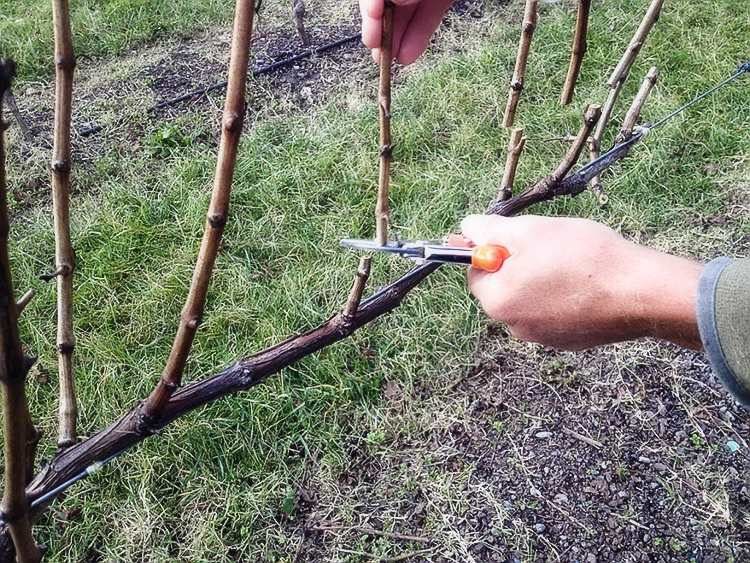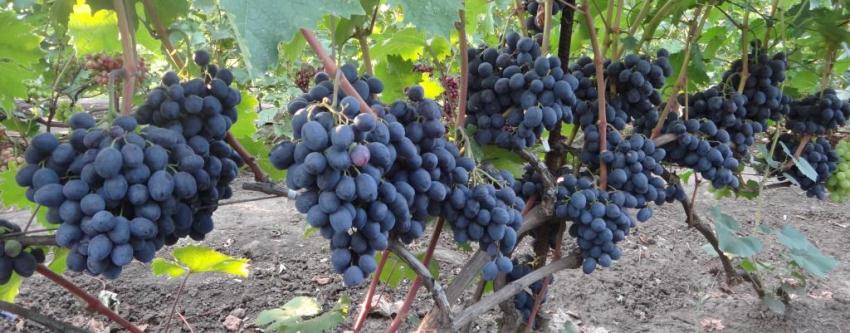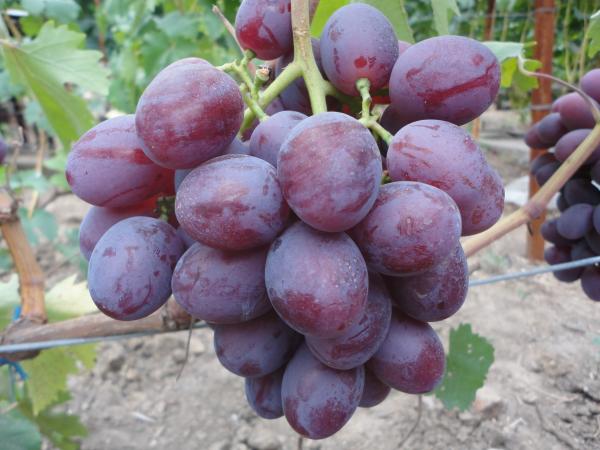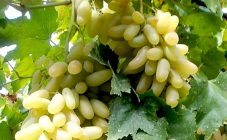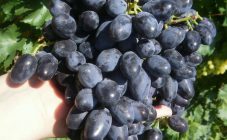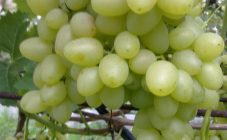Content:
Ruslan grape is a hybrid variety bred by the breeder V.V. Zagorulko by crossing several varieties. To create a new vine, varieties such as Kuban, Zaporozhye Gift and Rapture were used. The breeder made the main emphasis on increasing the frost resistance of the new type of grapes. The work resulted in a variety with an early ripening period, which can withstand temperatures down to - 22 ° C. The vine tolerates diseases typical of grapes well, has an increased yield.
Grade technical data
The characteristics given in the register of agricultural crops of Russia for the Ruslan grape variety are as follows:
- The growing season of the culture from the beginning of the appearance of the first buds to the formation of conditioned fruits lasts from 104 to 118 days. Due to the rapid growth of the brushes, Ruslan is harvested in the first week of August.
- The height of a fruiting plant ranges from 2-3.1 m.
- The vine ripens immediately along its entire length. It is covered with flowers of both sexes, so there is no need to specially pollinate the culture. To ripen the vineyard under normal conditions, it is recommended to leave 2 to 3 inflorescences on the shoot.
- Clusters ripen simultaneously on most of the planted shoots. The bunches do not rot, they have good moisture protection. They do not fall off under the influence of unfavorable climatic factors. Virtually even a novice grower with proper care will harvest 76% of the vine grown on the plant..
- According to various estimates, Ruslan's fruiting coefficient ranges from 1.2 to 1.4.
Description of fruits
In shape, the fruits of the plant resemble a regular ball or a slightly elongated sphere. The mass of each berry ranges from 10 to 20 g, and each of them contains 1-2 seeds of medium size. They are black or dark blue.
The grapes taste like plums. They are sweet, melt in the mouth pleasantly. The grape fruit has a sugar content of 17 to 18% with an acidity of 6-6.4 g / l.
A slight matte coating is noticeable on the peel, and it is easily chewed due to the relative thinness of the layer.
As most of the farmers, whose profession is viticulture, point out, Ruslan's brushes are almost always formed without peas.
The average bunch weight ranges from 0.5 to 0.9 kg. The smallest weight is obtained when the culture is cultivated in the Moscow region, and a larger number corresponds to the southern regions of Russia.
The brushes themselves are of medium to high density.
Ruslan belongs to table varieties, therefore after harvesting it is immediately handed over to consumers.
Landing methods
First, select suitable sprouts. They must have a strong and healthy root system and have 1 to 2 eyes. For seedlings to take root, they must be properly planted. There are 3 methods for planting young vines:
- When sowing in spring, the seedlings are set on their roots. If the trees have not yet woken up, this is done during the thaw, and from the middle of May, the awakened specimens are planted. In the autumn period, such work is performed from mid-October to the first frost.
- When the vine is already growing on the site, they are grafted onto the old root system. The seedlings germinate well and bear fruit in the first year. Both awake and dormant sprouts are suitable for these procedures.This method allows you to increase the immunity of plants to various diseases, while the percentage of vines that give a high yield increases. Breeders recommend inoculating the variety in the spring, after the disappearance of the night frosts. You can continue the process throughout the summer and autumn, until the first cold weather.
- Diversion landing. It is performed by choosing the desired length of the shoot of a mature vine. It is buried in the ground, waiting for it to take root in the soil. Such a seedling is cut after 12-24 months, or left unchanged. Any season is suitable for diversion works, but they cannot be carried out in early spring or late autumn.
When choosing a place for a vineyard, you must first set the depth of groundwater to prevent cracking of berries or rotting of the root system.
It is best if the groundwater is located at a depth of more than 2 m from the ground surface. To prepare a place for a seedling, it is recommended to use a drainage belt made of gravel and crushed stone, laid on the bottom of a pit (its dimensions are 0.8 X 0.8 X 0.8 m), dug out for planting a plant. 2 or 3 buckets of peat (humus) are poured there, and then covered with fertile soil. All this "construction" is defended for 2 weeks. After that, a young vine is planted in the pit. This is done so that the neck of the plant remains open. Then the seedlings are watered, mulch is laid on the ground.
It is recommended to tie all seedlings to strong stakes. Moreover, it is necessary to observe the distance between plants at least 150-160 cm. Ruslan-type bushes are distinguished by rapid growth, therefore it is advisable to leave them room for normal development. To do this, a gap of 300 to 320 cm must be maintained between the rows. This will protect the plants from various fungal and infectious diseases.
Before planting the vine, it is hardened at the moment when 2 leaves are formed. For this, a small hole is dug near the seedling, exposing the stem of the sprout. It is necessary to loosen the soil around each instance. This is necessary to improve the oxygen supply of young roots.
When the bushes are formed, the weakened branches are pruned with them, leaving only the most powerful and longest shoots. The work is recommended to be carried out in the summer, when several branches appear on the seedlings at once. Pruning allows the vine to focus on forming the most fertile part.
Practically no additional fertilization is required.
Watering of plants is carried out at least 1 time per week. Each bush needs up to 20 liters of water. It is advisable to carry out these works in the evening, after sunset. In order for all specimens to give the desired yield, it is recommended to remove the surface roots. This procedure is done in August using a pruner. The hybrid planted in the first year needs insulation. To do this, each bush is closed on top with a polyethylene bag.
If the hybrid is sick, in order to eliminate the danger of an epidemic, it is necessary to treat the plantings with appropriate antifungal drugs. When it is impossible to save diseased bushes, they are completely dug up, and then burned outside the site.
A big problem is the damage to plants by phylloxera. The female parasite lays a large number of eggs on the leaves of the hybrid. To destroy aphids, spraying of all the bushes with volatile hydrogen sulfide compounds is used.
When seedlings have broken branches or damaged root systems, they can become infected with bacterial cancer. To correct the problem, the gardener must carefully monitor the plantings.When an infected bush is found, it must be dug up and then burned.
Advantages and disadvantages of the Ruslan variety
Of the positive features of the variety, farmers note the high frost resistance, which allows planting plants in central Russia. The plant tolerates drought well.
Good taste parameters of berries and large brush weight attract a large number of consumers to them. Even the crumpled berry is good for consumption.
As practice shows, vine care is not particularly difficult even for novice gardeners. The crop is easy to propagate due to the ability of the seedlings to take root quickly. The variety has good immunity to mildew and mildew diseases.
Trade organizations willingly accept these grapes from the population, because they are stored for a long period. During transportation, the berries do not lose their shape and taste.
Ruslan's disadvantages are:
- the presence in each fruit of rather large bones;
- their tendency to cracking if the area has high soil and air humidity;
- with prolonged rains, the berries swell, become watery, their taste changes;
- intense heat is also destructive for a hybrid.
For the normal development of the vines, it is recommended to place the plantings in a dry, well-lit area. To do this, choose the southwestern or southern part of the courtyard. Although Ruslan tolerates severe frosts, it is better to wrap up the seedlings from freezing in the winter. Such work must be carried out every year if the plantings are located in central Russia.

